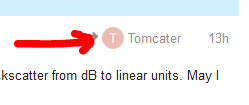I understand. but first I must do Pre processing, right? 'calibration - Speckle filtering …"
sorry for my english)
yes, calibration is always a good idea. Speckle filtering is optional, but when you do it, it is better before the index calculation.
accepted)
Thank you, Andreas!)
This is interesting in case you could add up an English version, in case it is available!
I wrote to the company where the author of this article works. If all goes well, of course, I will post all information here immediately.
Hi AstraVic,
the index you’ve mentioned above is called Radar forest degradation index (RFDI).
Look at this paper (HH ≈ VV): https://www.servirglobal.net/Portals/0/Documents/Articles/2019_SAR_Handbook/SAR_Vegetation%20Indices_one-pager.pdf
Hi!
Very interesting! Thank you!
By the way, I reread papers which i have, and, in my opinion, the authors had in mind a kind of interpretation of this.
But, I repeat, it is only my opinion, and I could be wrong.
And dielectric constant (moisture)… That’s the real issue. We are running some test. NDVI,RVI and EMSI. There is probably no correlation, however we are using Sentinel 1 images and formula created for RADARSAT images, so one would that formula need some modification. It also seems to us that it very much depends on ascending or descending position of satellite.
Hi Tom, can you please share your research?
In general, we can use like {10^((Value in db)/10)} to convert the backscatter from dB to linear units. May I know the reason to use absolute (ABS) in the conversion?
Would you please to share the source of this equation, many thanks.
siva_iirs is referring to tomcater’s post at #7 in this topic: Creating Radar Vegetation Index - #7 by Tomcater
You can click this icon to see if a post is a direct answer to a previous post and display it:

For dual-pol Sentinel-1 like data, RVI can be formed by 4*VH/(VV+VH). Here, VV and VH are in linear power scale, not in dB.
Be careful with the processing step (old SNAP7.0 version produces opposite channel c11==VV and c22==VH). However, latest version is working fine.
Read: Covariance Matrix C2 for Sentinel-1 --Diagonal Elements
Do you mean linear power scale can be obtained from covariance matrix C2 for Sentinel-1?
Yes, they can be obtained from C2 matrix. However, in a direct approach, radiometric calibration also provides Sigma0_VV and VH.
I disagree. You can derive T or C matrix out of the initial scattering matrix S, but not vice versa.
@ABraun Hi,ABraun.
Could you explain what the white area with high value( > 1) means in rvi image?
Rvi band
VH band
VV band
And I tryed servel sentinel-1 GRD scenes for rvi. Whatever there is white strip white area like above,there are always many pixeles with value greater than 1.
Does it make sense ?
Thanks for your time!
It looks like Radio Frequency Interference (RFI). There is a transmitter on the ground that is generating C-band RF emissions that are disturbing S-1 image formation.
Thanks for your reply. Do you have any idea about the pixels with value greater than 1 exept RFI?
At the moment,I don’t know how to handle those pixels.
The RFDI was developed based on all four polarizations. If you adjust the equation because you are using Sentinel-1 with only VV and VH, it is not surprising that the value range is a bit different. Unlike the NDVI it is not strictly limited to -1 and +1 but rather a relative measure of the presence of vegetation. Also, it fails at artificial structures, such as urban bodies.
Use the mask manager to identify RFDI pixels > 1 and check where in the image they are.




